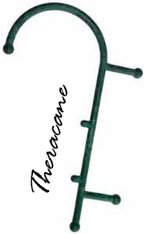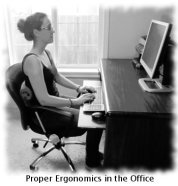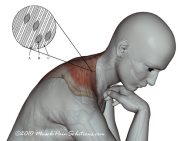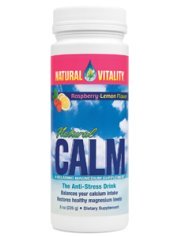Trigger Point Massage Therapy...
how to work on yourself!
Deep Stroking Massage
The principle behind deep stroking trigger point massage therapy is to create a micro stretch in the trigger point since the muscle fibers at that point are maximally shortened (see Trigger Point Treatment for the full explanation). The massage is done repeatedly throughout the day to encourage lengthening of the fibers, which will eventually eliminate the trigger point. This type of massage is based on the work of Janet Travell, MD and Clair Davies, NCTMB, author of The Trigger Point Therapy Workbook.
Trigger Point Massage Therapy Guidelines
|
|
Adapted from The Trigger Point Therapy Workbook by Clair Davies
|

1. Use a tool
This is a good idea whenever possible, because it helps to prevent injury to your hands and forearms while you work on other parts of your body. You will find that your hands will get tired quickly with trigger point massage therapy, and that there are places you cannot reach to treat on your body that are better treated with a tool. (See Trigger Point Tools for my favorites.)
2. Deep, slow strokes
Move the skin over the underlying muscle with your fingers, not your fingers over your skin. Ideally, you want to move at a slow enough rate that the muscle "melts" under your fingers. Don't worry if you can't feel when that happens. As long as you follow the directions for trigger point massage therapy, and move relatively slowly, you should get results. The idea is to get a micro stretch right under your fingers since that is where it is hyper shortened.
3. Massage in one direction, short repeated strokes
Again, since you are trying to create a micro stretch, massaging in one direction with short repeated strokes maximizes the stretch you are creating. Stroke up or down the muscle — which way is not important and can be switched from session to session. For best results, pick one direction per massage session.
4. Aim at a pain level of 5-7 on a scale of 1-10
You must do this massage firmly. It is not comfortable, but to re-establish normal muscle function at the site of the trigger point, you have to break the trigger point up. I have found that this pain level can be too high for some people... if it seems to be causing more pain at that spot and feels a little swollen, then give it some rest, and try the gentler Trigger Point Pressure Release method. Also, if you are getting bruises, you may need to back off a little. As your trigger points resolve, it will be harder and harder to get to a 5-7/10 on the pain scale.
5. Limit Massage to 6-12 strokes
If you work a trigger point too much at a time, you run the risk of inflaming it rather than resolving it. Work hard, deep, and slow... but then stop. This is the most effective way to self treat.
6. Work 3-6 times per day
Probably the most important part of these instructions is consistency - the more consistent you can be with trigger point massage therapy, the sooner they will resolve, and stop creating painful and annoying symptoms.
7. If you get no relief, you are probably working the wrong spots
If you have truly been consistently treating your trigger points according to the outline above, and you have not had any change in your symptoms, you are probably not getting to the pain generating trigger points, the primary ones. Secondary trigger points are often created by pain from other trigger points. If you are not treating the primary trigger points, then the secondary ones will be recreated consistently. Or you may need a less aggressive approach like the Trigger Point Pressure Release.
Pin and Stretch
With pin and stretch massage, you use finger pressure to pin the trigger point and then you stretch the muscle away to it's fully lengthened position. This is a bit harder to do because you need to know where the trigger point is, as well as how to stretch the muscle. Stretches will eventually be added for many of the muscles on this website, so you can find the trigger point, learn the stretch, and then combined the massage with the stretch... very effective, but you often need someone to help you will the harder to reach muscles.
Conclusions about Self Massage
As I mentioned above, the biggest key is persistence, but accuracy is important too. Make sure you are working the right trigger points. A manual such as The Trigger Point Therapy Workbook by Clair Davies is an important tool in figuring this out. If the Deep Stroking Massage approach causes too much guarding and pain, try the Trigger Point Pressure Release Method . It has the advantage of not hurting. However, if does not work for you, there could be several reasons:
Trigger Point too Irritated for Self Massage — In this case, any additional pressure is too much for the trigger point. A better method for a hyper irritated trigger point is ice and stretch.
Perpetuating Factors — If you seem to get some relief, but the trigger points keep coming back, there may be other primary trigger points that are recreating the ones you are treating. The other possibility is that you may be dehydrated, using the muscle in a way that is aggravating it, or not have the proper vitamins and minerals that you need.
Free PDF Summary for Professionals
You will need Adobe Reader (the latest version is recommended) installed on your computer in order to open and read this trigger point massage therapy summary. You can get Adobe Reader here (a new window will open so you can download it without leaving this page).
If you want to open the file in your browser window, just click on the link. However, if you want to download the file to view later, then right-click on the link and choose "Save Target As" or "Save File As." Then select where you want to save the file on your hard drive.
Return from Trigger Point Massage Therapy to Trigger Point Treatment
Return from Trigger Point Massage Therapy to Home



